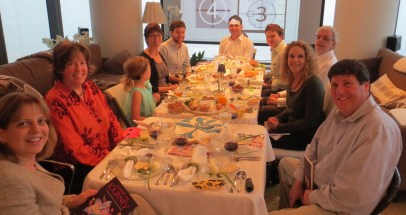As a kid, I knew better than to sneak comic books into services, but as an adult, that’s exactly what I’m doing–with the Visual T’filah I designed for the CCAR.
As an artist, I am constantly engaged in a conversation with the texts of our tradition. I’m a papercutter, and my work is visual biblical commentary; I call it “paper midrash.” I always begin with text—often biblical and other traditional sources, but also the words of poets and musicians. My work is influenced by elements of the natural world and how we understand our connection to the Divine: the burning bush, the parting of the Red Sea, the revelation at Sinai.
I incorporate cut-up comic books into my work, drawing parallels between comic book mythologies and religious traditions, to delve into the stories that make us human. In my Paper T’filah series I explore connections between comic narratives and contemporary Jewish liturgy.
It’s a good fit. Comic superheroes exist outside of the “natural” world, be they visitors from other planets or people whose powers stem from strange scientific accidents, and their struggles can be seen as a metaphor for the human experience. Their stories are woven into my explorations of prayer.
So my Barchu—which marks the beginning of the formal prayer service, the moment when we stop being just a group of individuals and become a community praying together—is made with comic book superhero teams. Yotzeir, which praises God as the Creator of light, is filled with comic book heroes whose powers are tied to light and color, such as the mutant musician hero Dazzler. V’ahavta is a prayer about teaching children the value and meaning of our tradition, and my papercut of that prayer is filled with younger heroes like the Teen Titans and the Legion of Superheroes. G’ulah leverages the Green Lantern “Blackest Night” storyline as a parallel to our story of slavery and freedom, and you can find Aquaman and the Sub-Mariner comics tucked into the parted waves of my Mi Chamochah.
The progression from papercut series to Visual T’filah was a bit challenging. Rather than just put pictures of my papercuts next to the prayers, I instead strove to combine my images with the words of our liturgy to provide an alternative or additional way to understand the prayers. I digitally cut and pasted and shaped the papercuts to work within the Visual T’filah format, creating something that is at once connected to the original papercut series and also something completely different: a projected illustrated siddur.
My wife Shawna and I have made Paper T’filah an element of the “Paper Midrash” residencies that we lead around the country: worship and study and papercutting workshops that bring together contemporary art, pop culture, and scholarship. The reaction has been overwhelmingly positive, and I couldn’t be more proud to have brought something new to their worship experience.
—
Isaac Brynjegard-Bialik is a Jewish artist living in Southern California. He cuts up comic books and reassembles them into work made of clean lines and patterns, sinuous shapes and sharp edges, large fields of color and small intimate spaces.
Paper T’filah by Visual T’filah is now available for purchase on the CCAR Press website. For more information on how you can bring Paper Midrash to your community, email Isaac or visit his website.







 ne amazing work so far. However, the finite amount of time she is able to dedicate to creating the Visual T’filah each week, given her other responsibilities around camp, meant that her scope was limited. Now with the introduction of the CCAR Visual T’filah Template (which includes the text of
ne amazing work so far. However, the finite amount of time she is able to dedicate to creating the Visual T’filah each week, given her other responsibilities around camp, meant that her scope was limited. Now with the introduction of the CCAR Visual T’filah Template (which includes the text of 

 I explained, but to be able to have this feature it would have to be an app, rather than an eBook. The challenge with custom apps, I continued, is that every feature we want to add, requires more resources and time. So, naturally we have to make choices based on priorities. Would we rather auto-select the service (when we can easily select it ourselves) or have bookmarking & note-taking? Conversely, if it’s an ebook, there are basic features of eReaders (like bookmarks & note-taking) that Apple, Kindle & Google already develop for their apps.
I explained, but to be able to have this feature it would have to be an app, rather than an eBook. The challenge with custom apps, I continued, is that every feature we want to add, requires more resources and time. So, naturally we have to make choices based on priorities. Would we rather auto-select the service (when we can easily select it ourselves) or have bookmarking & note-taking? Conversely, if it’s an ebook, there are basic features of eReaders (like bookmarks & note-taking) that Apple, Kindle & Google already develop for their apps. Features like hearing the prayer read or sung while words are highlighted are clearly meant for someone on their own. On the other hand, could a non-musical service leader use the audio to help lead the singing? Would we feel comfortable singing along with the beautiful audio recordings on an iPad, rather than a live human?
Features like hearing the prayer read or sung while words are highlighted are clearly meant for someone on their own. On the other hand, could a non-musical service leader use the audio to help lead the singing? Would we feel comfortable singing along with the beautiful audio recordings on an iPad, rather than a live human?










